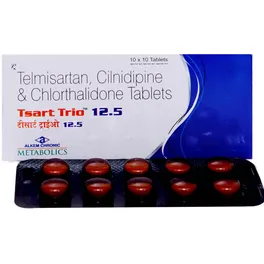Description
🩺 Cilnidipine 10 mg Tablet: A Comprehensive Guide
What is Cilnidipine 10 mg?
Cilnidipine is a prescription medication that belongs to the class of drugs known as calcium channel blockers (CCBs). It is primarily used to treat hypertension (high blood pressure). Cilnidipine uniquely blocks both L-type and N-type calcium channels, which helps in relaxing blood vessels, reducing vascular resistance, and ultimately lowering blood pressure. It may also be used in patients with certain cardiovascular conditions, especially when renal protection is desired.
Common Side Effects
Most people tolerate Cilnidipine well. However, some may experience mild side effects:
-
Dizziness or light-headedness (due to lowered blood pressure)
-
Headache
-
Flushing (warmth, redness of the face)
-
Swelling of ankles or feet (peripheral edema)
-
Fatigue
-
Palpitations
These symptoms are generally mild and often resolve as the body adjusts to the medication.
Serious Side Effects (Rare but Important)
Though uncommon, Cilnidipine can cause serious adverse effects that require immediate medical attention:
-
Severe hypotension (very low blood pressure)
-
Bradycardia (slow heart rate)
-
Heart failure symptoms (shortness of breath, sudden weight gain, swelling)
-
Liver dysfunction (elevated liver enzymes, jaundice)
-
Allergic reactions (rash, itching, swelling of the face or tongue, difficulty breathing)
If any of these occur, stop the medication and seek urgent care.
Monitoring and Follow-Up
Effective management with Cilnidipine includes regular monitoring:
-
Blood Pressure Monitoring: Regular home or clinic checks to assess drug efficacy.
-
Heart Rate: Especially in patients at risk of bradycardia.
-
Kidney Function Tests: Serum creatinine and eGFR should be checked periodically.
-
Liver Function Tests: If the patient shows signs of liver trouble or during long-term use.
-
Electrolyte Levels: Especially in patients with coexisting kidney issues or on diuretics.
Follow-up visits every 4–8 weeks initially, then less frequently once stable.
Warnings and Precautions
-
Use in Pregnancy and Breastfeeding: Not recommended unless prescribed; safety not established.
-
Renal Impairment: Use with caution; dose adjustment may be required.
-
Hepatic Impairment: May require dose modifications.
-
Driving and Machinery Use: Caution advised due to possible dizziness or drowsiness.
-
Elderly Patients: May be more sensitive to blood pressure-lowering effects.
Summary
Cilnidipine 10 mg is an effective calcium channel blocker used for managing high blood pressure, offering additional renal protection by acting on both L-type and N-type calcium channels. While generally safe and well-tolerated, it can cause side effects like dizziness, swelling, and, rarely, serious cardiovascular or liver issues. Regular monitoring of blood pressure, kidney and liver function, and overall clinical status is crucial for safe long-term use. Patients should be educated on symptoms of low blood pressure and advised to report any unusual reactions immediately.
Note: This information is intended for educational purposes and should not replace professional medical advice. Always consult a healthcare provider for personalized guidance.






